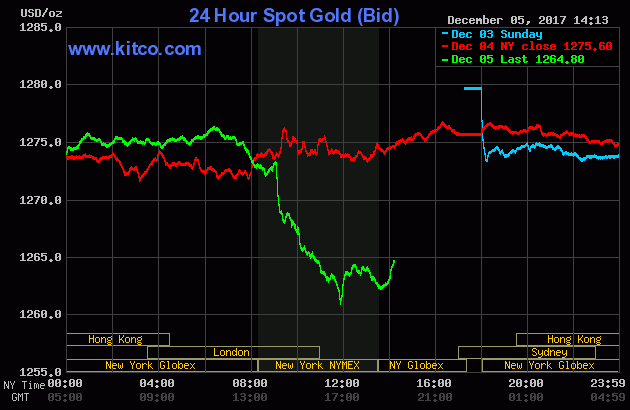On Monday, the Richmond Fed named Thomas Barkin to be its next president. What does it mean for the gold market?
Yesterday, we wrote that the approval of the tax bill by the Senate would create a negative sentiment toward gold, which would make it struggle until December 13. Indeed, as the chart below shows, the price of the yellow metal declined on Tuesday due to the strengthened risk appetites. Actually, gold prices fell to four-month lows.
Chart 1: Gold prices from December 3 to December 5, 2018.

Now, a lot will depend on how the tax reform unfolds. However, we will not be surprised if gold suffers more pain, at least until the December FOMC meeting. Gold prices need a catalyst to go higher. On Friday, the November payrolls will be published and they could send the price of bullion north if they significantly disappoint, but we would not bet on it.
Meanwhile, the Federal Reserve Bank of Richmond nominated Thomas Barkin as its new chief, effective January 1, 2018 (and the appointment has been approved by the Fed’s Board of Governors). Jeffrey Lacker was the former president, but he resigned in April due to a leak scandal (he telegraphed details of the FOMC meetings to a consulting firm). Since then, the post has been open, adding to the uncertainty about the composition of the FOMC in 2018. There are still many unknowns about the future Fed policy, but after Trump’s nomination of Goodfriend to the Board of Governors and Barkin’s designation to lead the Richmond Fed some of the question marks disappeared.
Thomas Barkin, age 56, gained a law degree from Harvard University. He is a senior partner in the Atlanta office of McKinsey&Company, but he was on the board of the Federal Reserve Bank of Atlanta between 2009 and 2014, and served as chair in 2013-14. Now, the question is: is he a dove or a hawk? The issue is very important, as the Richmond President will join the voting group at the FOMC in 2018. The problem is that Barkin’s views on monetary policy are not widely known, as he has no experience in monetary policy making. However, it is likely that Barkin will continue the hawkish stance of the Richmond Fed. Given that two doves – Neel Kashkari and Charles Evans – will not vote in 2018, the upcoming personal changes imply that that the composition of the FOMC in 2018 will move slightly from the dovish to the hawkish side, which should be negative for gold prices.













Leave A Comment